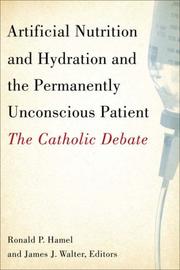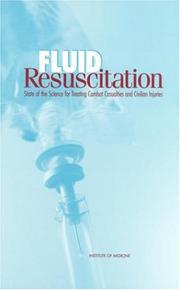| Listing 1 - 10 of 15 | << page >> |
Sort by
|
Multi
ISBN: 9781437706543 1437706541 9781437706550 143770655X Year: 2012 Publisher: St. Louis : Elsevier Saunders,
Abstract | Keywords | Export | Availability | Bookmark
 Loading...
Loading...Choose an application
- Reference Manager
- EndNote
- RefWorks (Direct export to RefWorks)
The leading reference for the diagnosis and management of fluid, electrolyte, and acid-base imbalances in small animals, Fluid, Electrolyte, and Acid-Base Disorders in Small Animal Practice, 4th Edition provides cutting-edge, evidence-based guidelines to enhance your care of dogs and cats. Information is easy to find and easy to use, with comprehensive coverage including fluid and electrolyte physiology and pathophysiology and their clinical applications, as well as the newest advances in fluid therapy and a discussion of a new class of drugs called vaptans. Lead author Stephen DiBar
Mammals --- Veterinary pathology --- Dogs --- Cats --- Veterinary fluid therapy. --- Diseases --- Treatment.
Book
ISBN: 1527542025 9781527542020 9781527540316 1527540316 Year: 2019 Publisher: Newcastle-upon-Tyne
Abstract | Keywords | Export | Availability | Bookmark
 Loading...
Loading...Choose an application
- Reference Manager
- EndNote
- RefWorks (Direct export to RefWorks)
This book is essential reading for medical or veterinary practitioners who need to understand the new fluid physiology and to apply it to the safe care of patients. The Starling principle is one of medicine's most important concepts and originates from Ernest Starling's laboratory research 120 years ago. However, inappropriate fluid therapy is now recognised as harming and even killing thousands of patients every year. In 2004, a landmark study was published which confirmed the hypotheses put forward by Sheldon Weinbaum and Charles Michel, among other physiologists, that, in most tissues and in most situations, capillaries filter fluid to the interstitium, but do not reabsorb it. This book draws together for the first time the evolving science of the steady-state Starling principle and the clinical evidence that reveals its applicability to safer patient care. It is a thorough re-appraisal of the basics of fluid therapy. The mantra of colloid boluses for plasma volume resuscitation and colloid-free isotonic salt solution for extracellular fluid volume does not explain observations from blinded clinical trials, and the expectation of benefit for resuscitation with colloids, particularly in respect of oedema, has not materialised. Now that there is consensus that colloid volume therapy should not be used in critically-ill patients, there is a pressing need for a new paradigm for fluid therapy. This book proposes an improved paradigm that takes into consideration the Starling principle, which has been neglected by clinicians and revised by physiologists in recent years. It retires the view of colloids as preferred plasma substitutes, and focuses instead on the central volume of distribution of an infused fluid, its rate of distribution to a peripheral volume, and its rate of excretion. In short, it emphasises volume kinetics.
Fluid therapy. --- Colloids --- Plasma exchange (Therapeutics) --- Therapeutic use.
Book
Year: 1994 Publisher: Washington, DC : National Academy Press,
Abstract | Keywords | Export | Availability | Bookmark
 Loading...
Loading...Choose an application
- Reference Manager
- EndNote
- RefWorks (Direct export to RefWorks)
Dehydration (Physiology) --- Water-electrolyte imbalances. --- Exercise --- Fluid therapy. --- Physiological aspects.
Book
Year: 2006 Publisher: [Place of publication not identified] Saunders Elsevier
Abstract | Keywords | Export | Availability | Bookmark
 Loading...
Loading...Choose an application
- Reference Manager
- EndNote
- RefWorks (Direct export to RefWorks)
Animal Diseases --- Drug Therapy --- Diseases --- Therapeutics --- Analytical, Diagnostic and Therapeutic Techniques and Equipment --- Dog Diseases --- Cat Diseases --- Fluid Therapy --- Animal Diseases. --- Drug Therapy. --- Disease. --- Therapeutics. --- Dog Diseases. --- Cat Diseases. --- Fluid Therapy.
Book
ISBN: 3030483746 3030483738 Year: 2020 Publisher: Cham, Switzerland : Springer,
Abstract | Keywords | Export | Availability | Bookmark
 Loading...
Loading...Choose an application
- Reference Manager
- EndNote
- RefWorks (Direct export to RefWorks)
This revised and expanded second edition presents the most recent evidence-based facts on perioperative fluid management and discusses fluid management from basic sciences to clinical applications and the patients’ outcomes. Recent advances in understanding the Revised Starling principle with new concepts in tissue perfusion and the most recent techniques of perioperative goal directed fluid management are described. The endothelial glycocalyx functions and the influence of fluid management on its integrity are covered in detail; moreover, the techniques for its protection are also discussed. The dilemma of perioperative use of hydroxyethyl starch solutions and the resurgence of interest in using human albumin as an alternative colloid is explored. The problems of using unbuffered solutions during the perioperative period and comparison between restrictive versus liberal fluid management are discussed in full. Lastly, case scenarios for every possible clinical situation describe in full the most up-to-date fluid management for the corresponding clinical problem. Perioperative Fluid Management, Second Edition is of interest to anesthesiologists and also intensivists.
Anesthesiology. --- Critical care medicine. --- Intensive / Critical Care Medicine. --- Intensive care --- Intensive medicine --- Medicine --- Emergency medicine --- Intensive care units --- Anaesthesiology --- Surgery --- Fluid therapy. --- Fluid replacement therapy --- Fluids --- Therapeutics --- Water-electrolyte balance (Physiology) --- Therapeutic use

ISBN: 1589012429 1435627253 9781435627253 9781589012424 9781589011786 1589011783 Year: 2007 Publisher: Washington, D.C. Georgetown University Press
Abstract | Keywords | Export | Availability | Bookmark
 Loading...
Loading...Choose an application
- Reference Manager
- EndNote
- RefWorks (Direct export to RefWorks)
During the past few decades, high-profile cases like that of Terry Schiavo have fueled the public debate over forgoing or withdrawing artificial nutrition and hydration from patients in a persistent vegetative state (PVS). These cases, whether involving adults or young children, have forced many to begin thinking in a measured and careful way about the moral legitimacy of allowing patients to die. Can families forgo or withdraw artificial hydration and nutrition from their loved ones when no hope of recovery seems possible?Many Catholics know that Catholic moral theology has formulated a well-
Religion and Medicine. --- Persistent Vegetative State --- Fluid Therapy --- Enteral Nutrition --- Catholicism. --- Euthanasia, Passive --- Euthanasia --- Artificial feeding. --- Fluid therapy --- Loss of consciousness. --- Persistent vegetative state --- Medical ethics. --- Fluid replacement therapy --- Fluids --- Therapeutics --- Water-electrolyte balance (Physiology) --- Blackouts (Loss of consciousness) --- Consciousness, Loss of --- Insensibility --- Unconscious state --- Unconsciousness --- Neurologic manifestations of general diseases --- Biomedical ethics --- Clinical ethics --- Ethics, Medical --- Health care ethics --- Medical care --- Medicine --- Bioethics --- Professional ethics --- Nursing ethics --- Social medicine --- Minimally conscious state --- Permanent vegetative state --- Persistent unawareness state --- Post-traumatic vegetative state --- Posttraumatic vegetative state --- PVS (Persistent vegetative state) --- Unawareness state, Persistent --- Vegetative state, Persistent --- Brain damage --- Loss of consciousness --- Coma --- Artificial nutrition --- Feeding, Artificial --- Nutrition --- Roman Catholic Ethics --- Roman Catholicism --- Roman Catholics --- Catholic, Roman --- Catholicism, Roman --- Catholics, Roman --- Ethic, Roman Catholic --- Ethics, Roman Catholic --- Roman Catholic --- Roman Catholic Ethic --- Medicine and Religion --- Parish Nursing --- therapy. --- ethics. --- Moral and ethical aspects. --- Religious aspects --- Catholic Church. --- Therapeutic use --- Moral and ethical aspects --- Patients --- Religious aspects. --- Health Workforce --- Comatose state
Periodical
ISSN: 15221466 1931857X Year: 1997 Publisher: Bethesda, Md. : American Physiological Society
Abstract | Keywords | Export | Availability | Bookmark
 Loading...
Loading...Choose an application
- Reference Manager
- EndNote
- RefWorks (Direct export to RefWorks)
Kidneys --- Body fluids --- Water-electrolyte balance (Physiology) --- Reins --- Liquides organiques --- Equilibre hydroélectrolytique (Physiologie) --- Periodicals --- Périodiques --- Kidney --- Équilibre hydroélectrolytique (Physiologie) --- Body fluids. --- Kidneys. --- physiology. --- Equilibre hydroélectrolytique (Physiologie) --- Périodiques --- APS-E EJMEDEC EPUB-ALPHA-A EPUB-PER-FT MDPHYSIO MDUROLOG --- Electrolyte-water balance (Physiology) --- Fluid-electrolyte balance (Physiology) --- Water balance (Physiology) --- Animal fluids and humors --- Body humors --- Fluids, Body --- Fluids and humors, Animal --- Humors, Body --- physiology --- Homeostasis --- Aquaporins --- Fluid therapy --- Osmoregulation --- Abdomen --- Urinary organs --- Nephrology --- Health Sciences --- Physiology --- Renal Replacement Therapy --- Ronyó. --- Fisiologia.
Book
ISBN: 0323355153 0323359086 1336234210 9780323359085 9780323355155 Year: 2016 Publisher: Philadelphia : Elsevier,
Abstract | Keywords | Export | Availability | Bookmark
 Loading...
Loading...Choose an application
- Reference Manager
- EndNote
- RefWorks (Direct export to RefWorks)
Water-electrolyte imbalances. --- Acid-base imbalances. --- Water-electrolyte imbalances --- Acid-base imbalances --- Water-Electrolyte Imbalance --- Acid-Base Imbalance --- Potassium --- physiopathology. --- diagnosis. --- metabolism. --- physiopathology --- diagnosis --- metabolism --- Water-electrolyte balance (Physiology) --- Acid-base equilibrium --- Kalium --- Alkali metals --- High-potassium diet --- Low-potassium diet --- Acid-base disorders --- Acid-base imbalance --- Imbalances, Acid-base --- Body fluid disorders --- Electrolyte disorders --- Electrolyte-water imbalances --- Imbalances, Water-electrolyte --- Water-electrolyte imbalance --- Electrolyte-water balance (Physiology) --- Fluid-electrolyte balance (Physiology) --- Water balance (Physiology) --- Homeostasis --- Aquaporins --- Fluid therapy --- Osmoregulation --- Potassium.

ISBN: 0309064813 9786610185962 1280185961 0309597013 0585084947 9780585084947 9780309064811 0309172799 Year: 1999 Publisher: Washington, D.C. National Academy Press
Abstract | Keywords | Export | Availability | Bookmark
 Loading...
Loading...Choose an application
- Reference Manager
- EndNote
- RefWorks (Direct export to RefWorks)
The challenges associated with immediate resuscitation of the wounded soldier are daunting and often unappreciated by civilian medical personnel. When you consider that field medics frequently work in less than friendly field conditions, exposed to the elements, while carrying only limited medical gear, potentially under fire, you get a sense for the extraordinary obstacles that must be overcome. Which technologies are best suited to this situation? What are the most promising research directions?
Hemorrhagic shock --- Fluid therapy. --- Resuscitation. --- Medicine, Military. --- First aid in illness and injury. --- Treatment. --- Wounded, First aid to --- Military medicine --- Reanimation --- Fluid replacement therapy --- Fluids --- Hematogenic shock --- Therapeutic use --- Assistance in emergencies --- Rescue work --- Wounds and injuries --- Medical emergencies --- Medicine --- Medicine, Naval --- Military hospitals --- Military hygiene --- War --- Critical care medicine --- Death, Apparent --- First aid in illness and injury --- Therapeutics --- Water-electrolyte balance (Physiology) --- Shock --- Treatment --- Medical aspects --- Relief of sick and wounded
Book
ISBN: 1461490820 1461490839 Year: 2014 Publisher: New York, NY : Springer New York : Imprint: Springer,
Abstract | Keywords | Export | Availability | Bookmark
 Loading...
Loading...Choose an application
- Reference Manager
- EndNote
- RefWorks (Direct export to RefWorks)
Fluid, Electrolyte and Acid-Base Disorders: Clinical Evaluation & Management is a clear and concise presentation of the fundamentals of fluid, electrolyte and acid-base disorders frequently encountered in clinical practice. Each chapter begins with pertinent basic physiology followed by its clinical disorder. Cases for each fluid, electrolyte and acid-base disorder are discussed with answers. In addition, board-type questions with explanations are provided for each clinical disorder to increase the knowledge for the clinician. Practical and clinically oriented, this book is a handy reference for practicing physicians, students, residents and fellows.
Fluid therapy. --- Veterinary medicine. --- Water-electrolyte imbalances. --- Electrolyte disorders --- Electrolyte-water imbalances --- Imbalances, Water-electrolyte --- Water-electrolyte imbalance --- Farriery --- Large animal medicine --- Large animal veterinary medicine --- Livestock medicine --- Veterinary science --- Fluid replacement therapy --- Fluids --- Therapeutic use --- Medicine. --- Critical care medicine. --- Internal medicine. --- Nephrology. --- Medicine & Public Health. --- Internal Medicine. --- Intensive / Critical Care Medicine. --- Body fluid disorders --- Medicine --- Animal health --- Animals --- Domestic animals --- Livestock --- Therapeutics --- Water-electrolyte balance (Physiology) --- Diseases --- Losses --- Intensive care --- Intensive medicine --- Emergency medicine --- Intensive care units --- Medicine, Internal --- Internal medicine --- Kidneys
| Listing 1 - 10 of 15 | << page >> |
Sort by
|

 Search
Search Feedback
Feedback About UniCat
About UniCat  Help
Help News
News